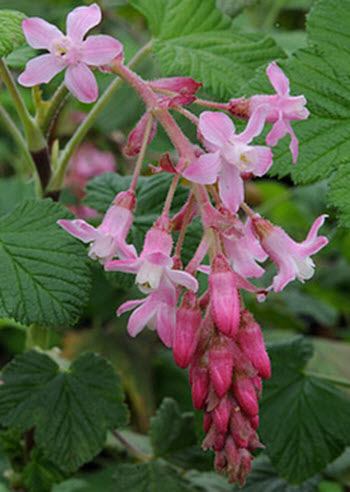Ribes sanguineum var. Glutinosum is also known under the common name “pink flowered currant”, it stands at 5 feet tall and are a deciduous shrub. You will be able to find this beauty all along the coastline of California and if you are lucky enough to run into it from January to March, you will get to see their long, drowsy, bright pink flower clusters hanging from the tip of its branches.
Morphology
 As mentioned this plant is a deciduous shrub which grows to around 5 feet. The bark of the stems has a muddy green color, with very noticeable pale brown strips. Its leaves grow regular and opposite of each other, they measure up to 7 centimeters in length and are palmately lobed with 5 individual lobes.
As mentioned this plant is a deciduous shrub which grows to around 5 feet. The bark of the stems has a muddy green color, with very noticeable pale brown strips. Its leaves grow regular and opposite of each other, they measure up to 7 centimeters in length and are palmately lobed with 5 individual lobes.
The flowers, which are what have given the plant its common name, are produced in mid-winter, grow up to 1 cm in length and gather in clusters of 5 to 30 flowers. The flowers have 5 petals and have a strong pink color. Upon pollination the flowers will turn into small dark purple berries which are edible, but have a very sour taste.
Habitat
Generally you will find pink flowered currant along the coast. It will usually be located in canyons and along northern turned slopes. This specific type of currant is special in the way that it likes shady environments and cannot deal with full sun exposure. The currant will not need large amounts of water and is considered relatively drought tolerant. You will often find them surrounded by Bays, Holodiscus and Tan Bark Oaks in complete shade and in thick and heavy clay soil. The specific habitats for this plant are; Closed-cone pin forests, mixed-evergreen forests, rivers and creeks and central oak woodlands.
Native Gardening
The Ribes sanguineum var. Glutinosum is great for gardening. It can be planted and used as an addition to your garden granary by providing berries that can be turned into jams and preserves. If your garden experiences frequent drought this currant type will help keeping your garden green during those periods. The Glutinosum is also great for sustaining wild life in your garden, its flowers can provide nectar for all the pollinators swarming around in your garden and its berries can feed a wide array of birds. As a Californian you should welcome this plant into your yard with open arms, and be a part of creating new native habitat.

